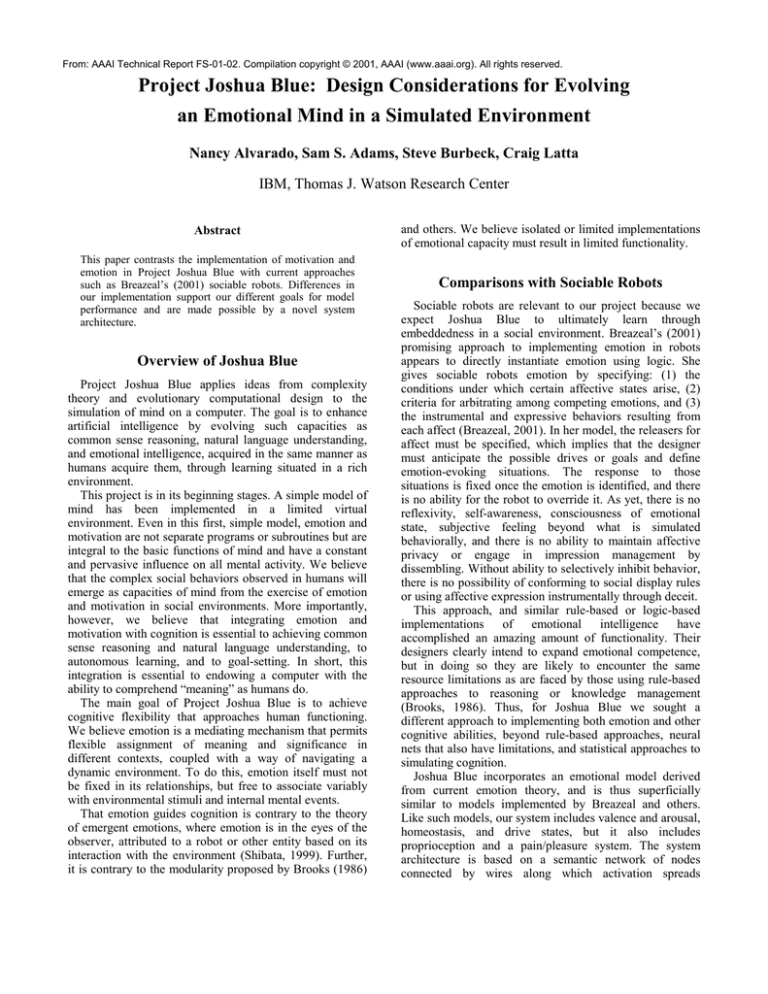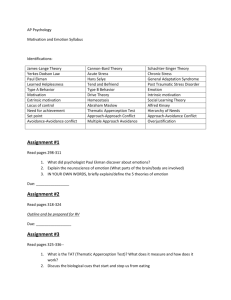
From: AAAI Technical Report FS-01-02. Compilation copyright © 2001, AAAI (www.aaai.org). All rights reserved.
Project Joshua Blue: Design Considerations for Evolving
an Emotional Mind in a Simulated Environment
Nancy Alvarado, Sam S. Adams, Steve Burbeck, Craig Latta
IBM, Thomas J. Watson Research Center
Abstract
This paper contrasts the implementation of motivation and
emotion in Project Joshua Blue with current approaches
such as Breazeal’s (2001) sociable robots. Differences in
our implementation support our different goals for model
performance and are made possible by a novel system
architecture.
Overview of Joshua Blue
Project Joshua Blue applies ideas from complexity
theory and evolutionary computational design to the
simulation of mind on a computer. The goal is to enhance
artificial intelligence by evolving such capacities as
common sense reasoning, natural language understanding,
and emotional intelligence, acquired in the same manner as
humans acquire them, through learning situated in a rich
environment.
This project is in its beginning stages. A simple model of
mind has been implemented in a limited virtual
environment. Even in this first, simple model, emotion and
motivation are not separate programs or subroutines but are
integral to the basic functions of mind and have a constant
and pervasive influence on all mental activity. We believe
that the complex social behaviors observed in humans will
emerge as capacities of mind from the exercise of emotion
and motivation in social environments. More importantly,
however, we believe that integrating emotion and
motivation with cognition is essential to achieving common
sense reasoning and natural language understanding, to
autonomous learning, and to goal-setting. In short, this
integration is essential to endowing a computer with the
ability to comprehend “meaning” as humans do.
The main goal of Project Joshua Blue is to achieve
cognitive flexibility that approaches human functioning.
We believe emotion is a mediating mechanism that permits
flexible assignment of meaning and significance in
different contexts, coupled with a way of navigating a
dynamic environment. To do this, emotion itself must not
be fixed in its relationships, but free to associate variably
with environmental stimuli and internal mental events.
That emotion guides cognition is contrary to the theory
of emergent emotions, where emotion is in the eyes of the
observer, attributed to a robot or other entity based on its
interaction with the environment (Shibata, 1999). Further,
it is contrary to the modularity proposed by Brooks (1986)
and others. We believe isolated or limited implementations
of emotional capacity must result in limited functionality.
Comparisons with Sociable Robots
Sociable robots are relevant to our project because we
expect Joshua Blue to ultimately learn through
embeddedness in a social environment. Breazeal’s (2001)
promising approach to implementing emotion in robots
appears to directly instantiate emotion using logic. She
gives sociable robots emotion by specifying: (1) the
conditions under which certain affective states arise, (2)
criteria for arbitrating among competing emotions, and (3)
the instrumental and expressive behaviors resulting from
each affect (Breazeal, 2001). In her model, the releasers for
affect must be specified, which implies that the designer
must anticipate the possible drives or goals and define
emotion-evoking situations. The response to those
situations is fixed once the emotion is identified, and there
is no ability for the robot to override it. As yet, there is no
reflexivity, self-awareness, consciousness of emotional
state, subjective feeling beyond what is simulated
behaviorally, and there is no ability to maintain affective
privacy or engage in impression management by
dissembling. Without ability to selectively inhibit behavior,
there is no possibility of conforming to social display rules
or using affective expression instrumentally through deceit.
This approach, and similar rule-based or logic-based
implementations of emotional intelligence have
accomplished an amazing amount of functionality. Their
designers clearly intend to expand emotional competence,
but in doing so they are likely to encounter the same
resource limitations as are faced by those using rule-based
approaches to reasoning or knowledge management
(Brooks, 1986). Thus, for Joshua Blue we sought a
different approach to implementing both emotion and other
cognitive abilities, beyond rule-based approaches, neural
nets that also have limitations, and statistical approaches to
simulating cognition.
Joshua Blue incorporates an emotional model derived
from current emotion theory, and is thus superficially
similar to models implemented by Breazeal and others.
Like such models, our system includes valence and arousal,
homeostasis, and drive states, but it also includes
proprioception and a pain/pleasure system. The system
architecture is based on a semantic network of nodes
connected by wires along which activation spreads
(Quillian, 1966; Collins & Loftus, 1975). In traditional
spreading activation models, the length of wires captures
semantic distance. In our model, the conductance of wires
is adjusted dynamically based on the emotional context.
This design permits cognitive processes and mental
representations to be continuously influenced by affect.
Further, like many current approaches, the system is
motivated and guided by affect to navigate its environment
and acquire meaning through principles of learning.
A key difference between our model and current
approaches is that emotion is implemented in both global
and specific ways. Like Breazeal’s (2001) model, our
system uses tags for valence, but not for arousal or stance.
When a node is activated, its valence influences the valence
of the entire system, but is also modified by the global
affect of the system. This makes possible emotionally
driven shifts in cognition. Arousal guides attention and
determines the strength of associations formed, interacting
with valence to tag specific objects with additional
significance. Affective weighting is important in
determining which associated objects will cross a threshold
for consciousness or be retained in memory. Proprioceptors
for affect were implemented to permit the system to
introspect on its own global affective state, to be aware of
the affect associated with a specific set of objects, and to
experience pain and pleasure. This latter constitutes the
reward and punishment system that guides exploratory
behavior, generates expectations and ultimately motivates
goal-directed behavior.
Unlike Breazeal, we have made no attempt to instantiate
Ekman’s basic emotions. We believe such states will
emerge from learning and social interaction, providing a
test of current emotion theories. Aside from the motive to
seek pleasure and avoid pain, we are also incorporating a
more complex structure of drives. We reserve the term
“drive” for innate or hard-wired motives essential to
survival, such as hunger or thirst in humans. Beyond that,
the coupling of affect and experience should result in the
formation of acquired motives and associated goals that
have attained emotional significance through social
learning (Reeve, 1997).
Breazeal (2001) uses positive emotions to signal that
activity toward a goal can terminate and resources can be
released. Neuropsychological evidence supports the idea
that pleasure indefinitely sustains seeking or approach
behavior, while other mechanisms indicate satiety
(Panksepp, 1998). In our system, positive affect or pleasure
arises not only from consummatory behavior but also from
the exercise of certain intrinsic cognitive processes that
require no homeostatic regulation (e.g., autonomy and
control, familiarity and liking, competence and self esteem,
social attachment). Pleasure is thus not a signal to terminate
a drive state but a motive for approach behaviors. To
terminate goals, our model incorporates the notion of
quasi-needs, social-needs and deficit motivations. These
needs are acquired motives that give rise to negative affect
when unsatisfied (e.g., need for power, social status,
achievement). Negative affect is reduced and goes toward a
neutral state once such a need is satisfied, terminating the
goal. This reduction in negative affect is itself reinforcing,
and demonstrates the importance of implementing the
capacity for relativistic subjective states. Stance is
determined by whether pleasure or relief of pain is the
guiding motivation. While more complex, this
conceptualization permits acquisition of an endless array of
motives and goals without the need to hardwire them as
drives. It also more closely resembles human functioning.
Our early experience with this model suggests that
establishing exact homeostatic set points and bounds is not
critical to system functioning. Attaching negative affect or
pain to homeostatic imbalances creates temporary drive
states that motivate regulatory behavior. We have observed
that the same behavior results regardless of the values
established. Instead, the temporal cycles for satisfying
drives vary with differences in the strength of affect arising
from imbalances, resulting in behavioral differences
comparable to temperament observed in humans. Unless
the system is placed in an environment where satisfaction
of imbalances is impossible, extremes are never reached,
obviating the need for boundaries. Our system can function
without predetermining “correct” set points or boundaries
because the system’s emotional behavior is not defined on
the basis of its distinct homeostatic drive states, as it is in
Breazeal’s (2001) model.
When emotion arises as a fixed consequence of
cognition or of some appraised environmental event, affect
does not guide or influence cognition but is determined by
it. We believe flexible thought can be achieved by linking
affect to semantic meaning and using affect as a weighting
mechanism, a significance indicator, a tuning mechanism
for attention and memory, a choice mechanism, and a
motivator of situation-appropriate behavior linked to
accomplishing desired goals. This potential for flexibility
is diminished when emotionality is specified to a system,
not emergent from it.
References
Breazeal, C. 2001. Designing Sociable Machines. The MIT
Press. Forthcoming.
Brooks, R. A. 1986. Achieving Artificial Intelligence
through Building Robots. MIT AI Lab Memo 899.
Collins, A. & Loftus, E. 1975. A spreading-activation
theory of semantic processing. Psychological Review, 82,
407-428.
Panksepp, J. 1998. Affective Neuroscience. Oxford Press.
Quillian, M. 1966. Semantic Memory. Cambridge, MA:
Bolt, Beranak and Newman.
Reeve, J. 1997. Understanding Motivation and Emotion,
Second Edition. Harcourt Brace College Publishers.
Shibata, T., T. Tashima, & K. Tanie 1999. Emergence of
Emotional Behavior through Physical Interaction between
Human and Robot, Proceedings of the 1999 IEEE
International Conference on Robotics and Automation
(ICRA’99), Vol. 4, Page(s): 2868 –2873.




